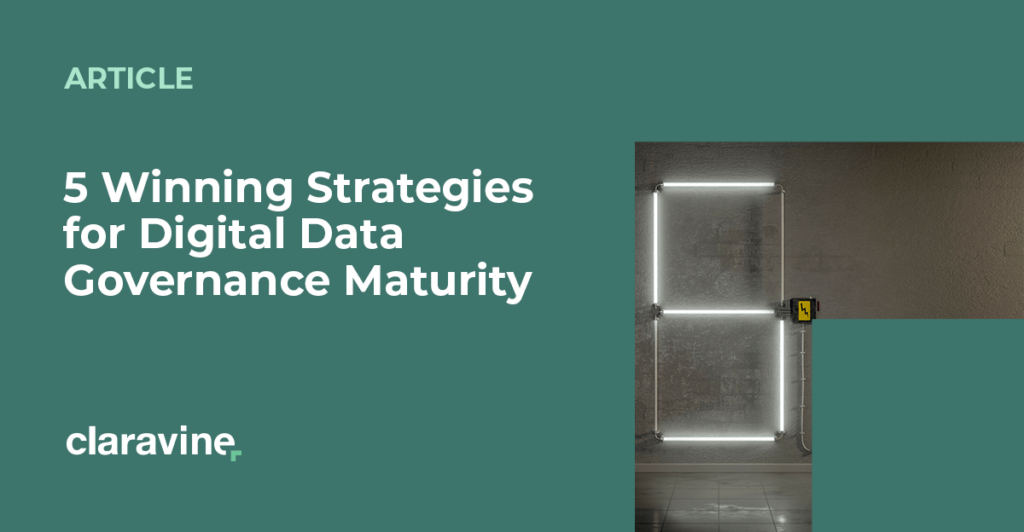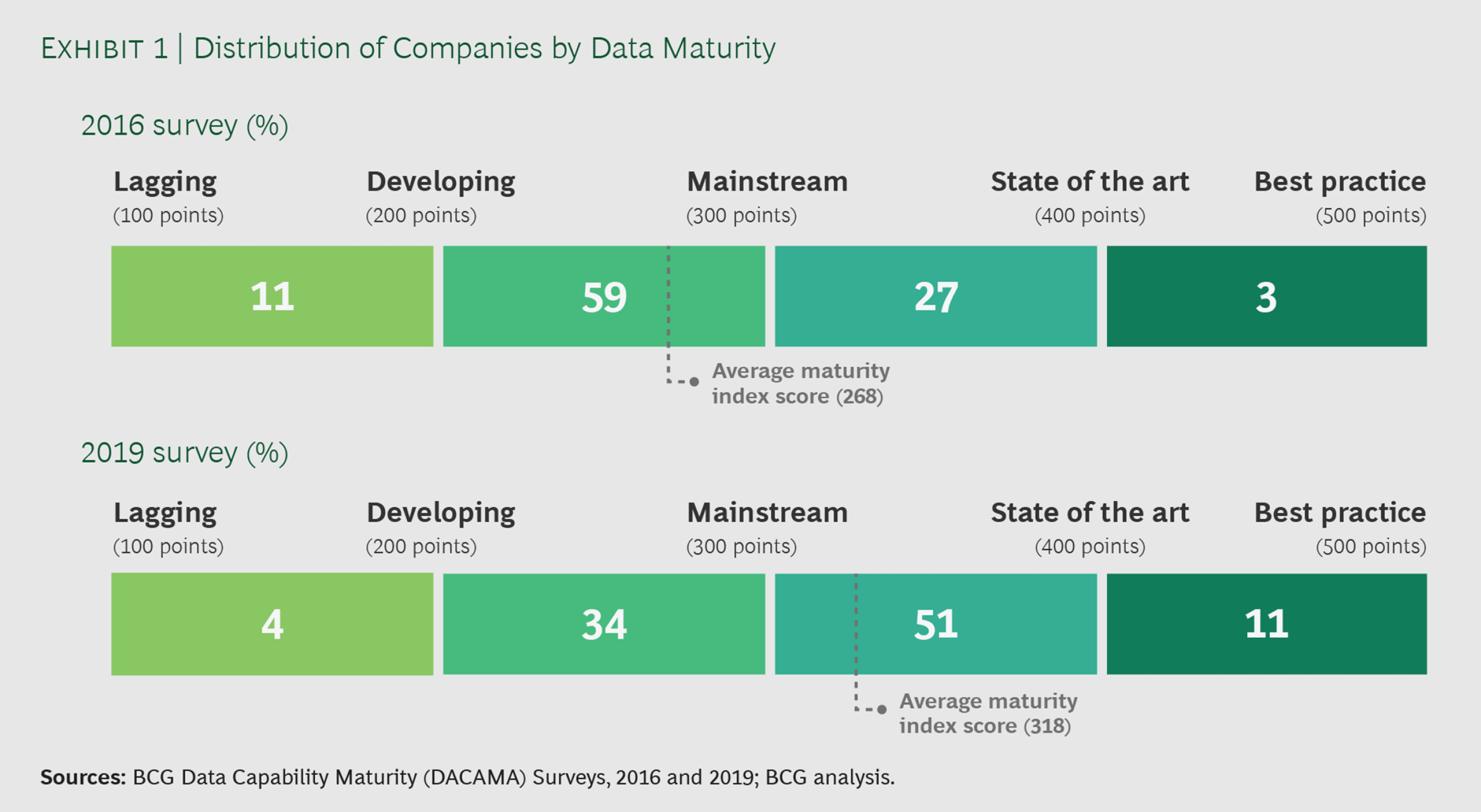5 Winning Strategies to Achieve Digital Data Governance Maturity

In the new data economy, the marketing opportunities seem endless. Data is the new oil. Sky is the limit. Right? But why does all the hype seem to gloss over the obstacles around data? Marketers on the front lines seem to be experiencing a very different reality – and struggle with implementing any type of usable data governance maturity model. Gartner measures the average financial impact of poor data on businesses at $9.7 million per year. And nearly a third of customer and prospect data is believed to be inaccurate. MIT reports knowledge workers waste up to 50% of their time dealing with monotonous data quality issues.
The dream of democratizing data seems further away. Instead of focusing on value-add activities, marketers end up spending their time on fire drills and investigating discrepancies with their data. If you can’t trust the quality of the data that are driving processes like segmentation and lead generation, how can you trust the integrity of your marketing efforts? The classic example is conflicting data and segmentation rules across marketing tools, which leads to an infinite loop whereby an email campaign automatically resends to the same customers multiple times. Or a feature flag is turned on to enable campaigns in one tool, but unexpectedly blocks data capture in another.
All of this adds up to the fact that most companies are not well organized around – and therefore don’t trust – their own digital data. A 2019 survey from BCG found that companies significantly underperformed against targets for a key data maturity index. They were especially lagging in areas such as analytics, vision and data governance.

So as a manager, where do you begin to try and make your data “marketing ready”, whereby it is clean, accessible, trustworthy and secure. This job has often been left to IT and/or data management operations teams. Or some companies outsource the work to outside agencies or consultants who will try and sell a “proven” data governance maturity assessment. It seems like a no brainer exercise, right? But wait. Can you even explain what it is? How will you get exec buy in? Who should participate? How will you measure progress? And how do you know what flavor is right for your org?
In this post, I’ll provide a few strategies to help you identify the best approach to your marketing data governance strategy and how to develop a maturity model that is tailored to meet the needs of your organization.
What is digital data governance?
A variety of definitions exist, but here are a couple of generic definitions you can use:
“Data Governance is the exercise of authority and control (planning, monitoring, and enforcement) over the management of data assets.” (DAMA International).
“Data governance is the practice of organizing and implementing policies, procedures, and standards for the effective use of an organization’s structured / unstructured information assets. Data governance is accomplished through the acts of data stewards, who exercise the careful, responsible management of data entrusted to them on behalf of others. The data governance framework includes the intersection of and relationship with data quality, metadata management, and master data management for a comprehensive information management strategy administered by data stewards. (Note: owners and stewards are NOT interchangeable, owners have power and control, stewards manage on behalf of the owner, perhaps without control over the resource / object).” (EIMI)
I can already hear the grumbling: “Um, great. Thanks a lot – so now what?“
These generic definitions can make it seem like an overwhelming exercise. Even if you are data savvy, it’s too big a job for any marketer to chew off. Data is everywhere, so how can you possibly reign it all in? And is this what you wanted for your career?
Here are a few tips to make a winning digital data governance strategy that is accessible and achievable for marketers:
#1: Get leadership buy-in through relevance
As marketers, you’re used to working with data every day, so you understand the importance of data governance. But to get buy in, you will likely need to present a holistic data governance strategy to your superiors. To avoid sticker shock, it may be best to break it out into consumable chunks, with a focused proof of concept to kick it off. Even then, the value and urgency may not always be crystal clear to the C-suite. Before implementing a strategy, you may want to involve the chief information officer or chief data officer. The best way to communicate the need effectively will be through context. Frame the conversation around risk and cost savings through more efficient marketing spend. Outline the problem so it’s relevant to their jobs and make it a win-win for all sides. Ask questions like, “Are you getting the analytics and marketing reports you need to make accurate, on time and informed decisions?” or “Are you aware of the security and compliance risks of ungoverned data?” Raising consciousness around both the risks and the benefits can be an effective way to leverage and sell a sound data governance strategy.
#2: Don’t boil the ocean
Data governance consultants are quick to try and sell massive, cross-departmental initiatives to implement a data governance strategy across the enterprise (sales, marketing, finance, IT, operations). And while yes, the end goal is data governance across the org (not just functional silos), you need a realistic place to start. Identify the biggest relevant pain points in your day to day role as an analyst or marketer. Then develop a strategy around those specific problems. Some companies kickoff their data governance strategy by tackling marketing data insights or digital data quality, focusing on analytics and clickstream data from their websites and mobile apps. It’s limited enough in scope that it can serve as an achievable proof of concept for expanding data governance across the enterprise. Also, cleaning up digital data can prove to have real tangible value to the rest of the company.
#3: Approach maturity models with a grain of salt
The first thing your data governance consultant will likely try and do is sell a maturity assessment. It seems straightforward. You run the assessment to determine your current maturity level and take action to get to the next level. Established capability maturity models (CMM) rank companies on levels of data governance maturity starting at “Unaware” all the way to “Effective” or “Optimizing.”
But buyer beware. Data governance has been around longer than the ne
w data economy. Many variants of the data governance maturity model and assessment were developed for more traditional disciplines such as IT. However, in the new data economy driven by dynamic marketing, such generic models may be inadequate. One Forrester report states, “Maturity models are useful for very stable and well known capability domains. But with big data, cloud, BI self-service, extended enterprises, personal information management, and open data, to cite a few big changes, data governance will evolve drastically to a more business-oriented governance reflecting a new set of business decisions.”
In other words, there is no single data governance framework that works for everyone. It is critical that you as the champion work to develop a highly tailored data governance maturity model that aligns with your company’s unique digital strategy and will empower (rather than hinder) your people, process and technology.
#4: Empower a dedicated team of experts for a limited proof of concept
As a marketer, you are an important consumer and owner of the data. But data governance might not be what you had in mind for your career. One of the advantages to being in a large company is the amazing breadth of talent and skillsets available. To be successful, you will want to find the most passionate analysts and data management gurus who live and breathe data every day. Find and elect them to be your data stewards. They can be empowered as a new cross-discipline SWAT team focused on developing leading edge best practices to fix marketing data quality and institute training. And instead of data governance, it might be called the digital data center of excellence.
Once you’ve identified a specific pain point for the proof of concept, the first step is to identify how to measure the problem, which can lead to metrics for data maturity. For example, let’s say the POC is to improve digital data quality. The new SWAT team can lead the exercise by identifying KPIs for data quality. An example might be revenue fidelity. How does revenue sourced from your digital analytics software (installed on your website) compare to revenue sourced from your backend data warehouse? A “data fidelity” score (i.e. 90% fidelity) is born and can be used to track progress.
Now that you have a KPI, the team can then move into developing new processes to address and communicate data issues, manage issue remediation and fix reporting. It could be as simple as adding ‘data outage’ event markers to dashboards or leveraging new technology, such as a better tracking code tool and structure to improve campaign data capture. Easy, quick wins can yield massive benefit.
#5: Establish operational cadence and invest in training
Congrats – you’ve got governance! Your SWAT team has successfully developed a new framework for measuring, collecting and tracking data, analytics and reporting issues in a single place. But governance does not stop there. Now it’s time to operationalize it. A new operational team should be formed to establish cadence with weekly or bi-weekly data quality meetings, addressing the ongoing backlog of issues. Use agile methodologies and tools like Jira to easily track and assign issues across teams. Make sure you’ve established accountability, responsibility and clear communication with the various external “non-data” teams (IT, Product, Dev, QA, etc) who are responsible for making fixes and preventing issues.
As the team meets and communicates regularly with product teams and stakeholders, the list of long-standing data issues will begin to diminish. This should free the team up to be more proactive and address bigger strategic problems, like developing new data management policies and practices. This is a great time to re-invest in analytics training, so that stakeholders can begin accessing and trusting the data again. Establish weekly office hours for stakeholders to join and help them move to a self-service reporting model, allowing them to better understand how to interpret data, create customer segments and gain better insights. All of this adds up to activating a sustainable plan to maintain a clean data ecosystem.
In Summary
As organizations scale their data-driven digital transformations and compete on customer experience, the data for those experiences should eventually be governed across all customer-facing functions in the org, not within functional silos. That fact, combined with the fast-growing volumes of big data, can make data governance an intimidating exercise for marketers to undertake.
But it doesn’t have to be. With all the benefits of improved cross-functional communication, measurement and accountability, it can be a worthy strategic endeavor. Obtain leadership buy in and recruit a dedicated team of data stewards who can be on your side. Digital marketing data can serve as an ideal proof of concept for the larger enterprise strategy. As your company scales and grows its overall data governance maturity, your team can take pride that they helped launch the effort from the ground up. The result will be an improved data ecosystem with higher data fidelity, combined with fewer data outages and anomalies. The outcome is restored stakeholder confidence, enhanced loyalty and a truly data-driven customer experience.
About the Author
 Tom Arundel is Director of Digital Product Performance for Marriott International. With over 20 years leading digital data and transformation initiatives for Fortune 500s, Tom has led the development of several successful digital data and operations models, helping grow revenue to $20B for Marriott.com and its Native apps. Tom is also CEO of Accuitive Digital Consulting, helping companies with digital transformation and data center of excellence services.
Tom Arundel is Director of Digital Product Performance for Marriott International. With over 20 years leading digital data and transformation initiatives for Fortune 500s, Tom has led the development of several successful digital data and operations models, helping grow revenue to $20B for Marriott.com and its Native apps. Tom is also CEO of Accuitive Digital Consulting, helping companies with digital transformation and data center of excellence services.



